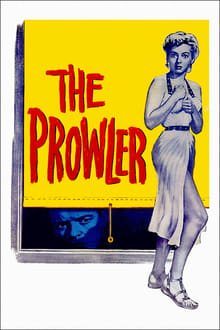
Edgy noir piece in desperate need of a wider audience.
Van Heflin plays Webb Garwood, a grumpy and unhappy cop who is called to investigate a suspected prowler at the home of Susan Gilvray (Evelyn Keyes). Garwood is smitten with the young and attractive woman from the off, and sensing her marriage to a late night radio personality is far from happy, he sets about wooing her, obsessively. It's the start of a coupling that is going to travel down a particularly dark road.
The film opens quite brilliantly with a quick shift of tone, Susan Gilvary is pampering herself in her bathroom, we see her from the window, domestic contentedness. This shot is accompanied by jaunty and jolly music, but then in the blink of an eye, she spies something out the window (it's us you know), a scream, the music becomes troubled and she draws the blind. Welcome to Joseph Losey's creepy skin itcher, The Prowler.
Very much a two character piece, The Prowler flips the favoured femme fatale formula around to great effect. Here it's the male protagonist that is the seducer, a cop no less, the abuse of power hanging heavy over proceedings like, yes, some "prowler" lurking in your back garden. It's made clear to us very early on that Garwood is troubled, he's up to no good, with a snarl here and a shifty smirk there, we just know that poor Susan is under threat from a man meant to protect her. Yet in a perverse piece of writing, Garwood surely does love Susan, but the bile within and the skew whiff way he now views the world-and his place within it, has ultimately made him a most dangerous anti-hero. It's evident that the makers here are wryly observing, but without preaching about, the shady underbelly of the American dream, the social differences of the two characters a most intriguing aspect of the story. As is the shift from the affluent setting of the Gilvray home in the first half of the piece, to the finale played out amongst the ghost towns in the Mojave Desert. The desolation of the landscape has rarely been so apt in a noirish world.
Technically The Prowler boasts high quality. Losey's direction is tight and holds the viewer in a vice like grip, while the art direction from Boris Leven is superb, particularly in that first quarter as the bright Gilvray house is cloaked in sparse darkness. But it's with Heflin, and to a lesser extent, Keyes, that the film reaches its high points. Keyes' character frustrates immensely, her decision making annoys and her surrender to Garwood is at first hard to swallow. But this is a testament to the good work that Keyes does, that she can induce these feelings for the character is surely a job well done. Heflin, tho, is a different kettle of fish. A criminally undervalued actor in his generation, Heflin serves notice here that he could play a bad guy convincingly, almost terrifyingly so too. His shift from meek, almost puppy dog love yearner, to conniving bastard is handled adroitly and gives film noir one of its best homme fatales.
Back on release big hitting critics such as Manny Farber and Wallace Markfield unreservedly praised the film. While pulp writer supreme James Ellroy is quoted as saying it was one of his favourite films. So it's somewhat surprising that it took until late 2010 to receive a DVD release, that, much like the machinations of Webb Garwood, is very much a crime. Moody, bleak and corrosive in its telling, this is a must see for noir and Heflin purists. 9/10